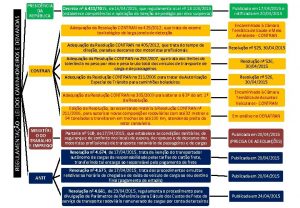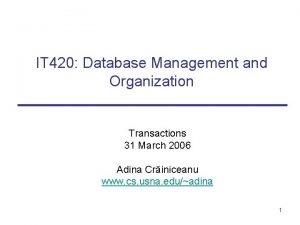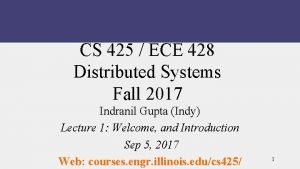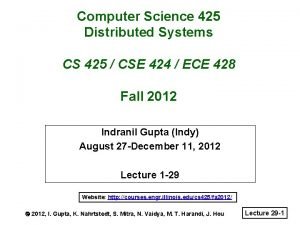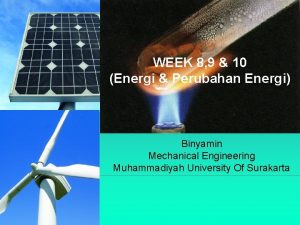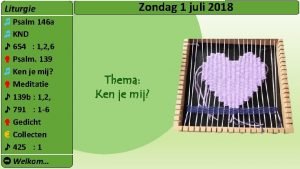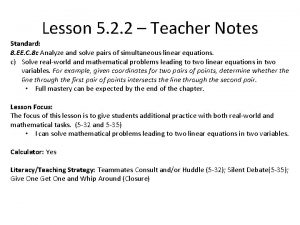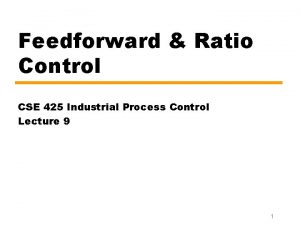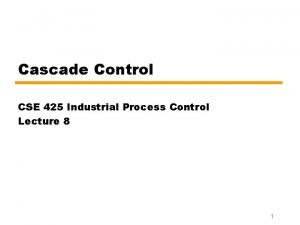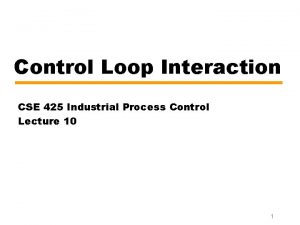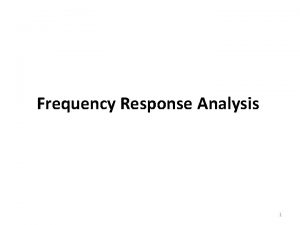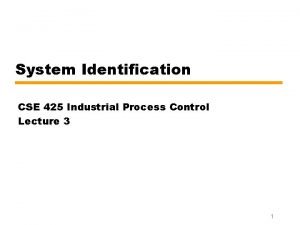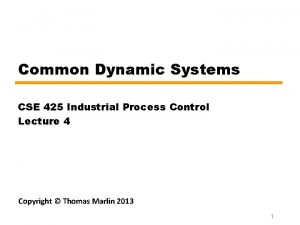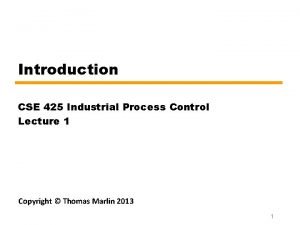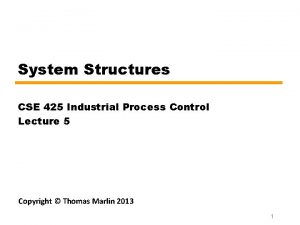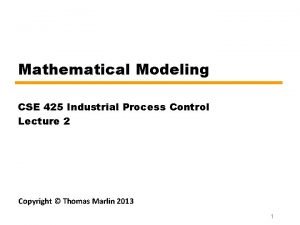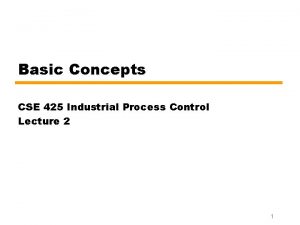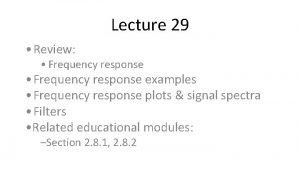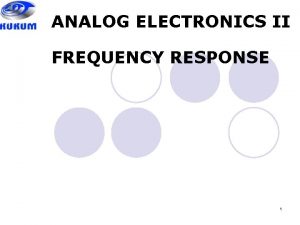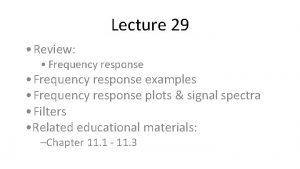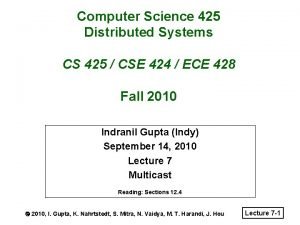Frequency Response Analysis CSE 425 Industrial Process Control

















- Slides: 17

Frequency Response Analysis CSE 425 Industrial Process Control Lecture 7 1

Objectives • Review the frequency response analysis. • Test system stability using Bode’s method. • Explain the physical meaning of gain and phase margins. 2

Frequency response analysis • Determines the response of system to a sine input. Sine in sine out • Perfect sine input doesn’t frequently occur in plants. • However, useful generalizations about control performance and robustness can be learned from frequency response analysis. 3

Frequency response of mixing tank Time-domain behavior. Bode Plot - Shows response for a range of frequencies • 20 Log (AR) vs log( ) • Phase angle vs log( ) 4

How to calculate frequency response? • The frequency response can be calculated from the transfer function G(s) by setting s = j , where = frequency. • In MATLAB, the commands abs and angle give the magnitude and angle of a complex number. 5

Frequency response & stability • When we design a control system, we have to insure that the closed-loop system is stable. • A system is stable if any bounded input to the system results in bounded output. • Stability is determined from the roots of the characteristic equation of the closed-loop system. Calculating the roots is easy with standard software. • However, if the system has a dead time, the term e- s appears in the equation and we need another method: Bode Stability Method. 6

A thought experiment • Consider a closed loop system where one cycle of sinusoid is put in. Disconnect the feed back at the summer and measure the feed back over a wide range of frequencies. • At a certain frequency pc, there is a phase shift of 180˚ between input and feedback signal due to loop dynamics. The minus sign (in the summer) will delay this feedback signal another 180˚. This results in a total delay of 360˚ with respect to the input. • If the sine is larger in amplitude after one cycle; then it will increase each “time around” the loop. The system is unstable. 7

Bode stability method Let’s put the results together. GOL(s) includes all elements in the loop (i. e. the open-loop transfer function). At the critical frequency: GOL(j pc) = -180 The amplitude ratio: |GOL(j pc) | < 1 for stability |GOL(j pc) | > 1 for instability The gain margin (GM) is defined as: If the gain margin is less than 1 (negative in d. B), the system is unstable. 8

Phase Margin • Another relevant term is the phase margin (PM). • To calculate PM, we find the gain crossover frequency ( gc) at which the open-loop gain crosses unity. • The phase margin is the distance between the open loop phase and -180 at frequency gc. • If the phase margin is negative, the system is unstable. 9

Interpretation of GM & PM • GM tells us the maximum proportional gain we are allowed to use without affecting system stability. • PM tells us the maximum additional phase that can be added to the loop without affecting system stability. • PM can be used to evaluate the time delay margin (DM) which is the maximum additional time delay that can be added to the loop without affecting system stability. 10

Example Given the following process: Find the gain, phase and delay margins for the closed-loop system. Is the system stable? Answer • The frequency response function is: 11

• To find GM, we need the phase crossover frequency. • At this frequency: • Therefore, GM = 1/0. 735 = 1. 36 = 2. 63 d. B (i. e. the system is stable). • To find PM, we need the gain crossover frequency. 12

• At frequency wgc: • We can check the results using the command margin s=tf(‘s’); G=2/(s+1)^2*exp(-s); margin(G) 13

• Let us now use Simulink to interpret GM and PM. • For this purpose, we build the following model: 14

Closed-loop step response Proportional gain = 1, System is stable. Proportional gain = 1. 4, System is unstable. Remember: gain margin is = 1. 36. 15

Closed-loop step response Proportional gain = 1 and 0. 6 seconds additional delay System is unstable. Remember: delay margin = 0. 57. 16

Dead Time • Dead-time is common in chemical processes. It can arise from: • Transportation lag (long pipelines) • Slow measuring device. • Large number of first-order systems in series (e. g. distillation column). • Sampling delays introduced by computer control. • Due to dead-time, the effect of a control action is not seen at the controlled output for a while. This causes the controller to overreact and take additional unnecessary compensation which results in more oscillatory response. 17
 Marginal relative frequency
Marginal relative frequency Expected relative frequency
Expected relative frequency Angular frequency to frequency
Angular frequency to frequency Vmax shm
Vmax shm Frequency vs relative frequency
Frequency vs relative frequency Marginal frequency distribution
Marginal frequency distribution Joint frequency vs marginal frequency
Joint frequency vs marginal frequency Resolução 425 do contran
Resolução 425 do contran Area code 425
Area code 425 Ece 428 uiuc
Ece 428 uiuc Distributed systems course
Distributed systems course Pada perubahan dari 12 425 gram karbon menjadi co2
Pada perubahan dari 12 425 gram karbon menjadi co2 Singel 425
Singel 425 Psalm 425
Psalm 425 Nancy started the year with $425 in the bank
Nancy started the year with $425 in the bank Ece 425
Ece 425 Ece 425
Ece 425 Opwekking 428
Opwekking 428







